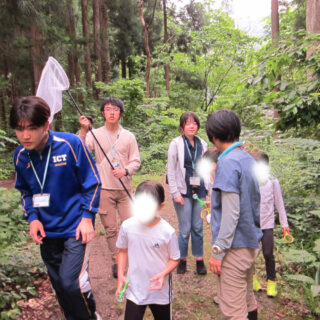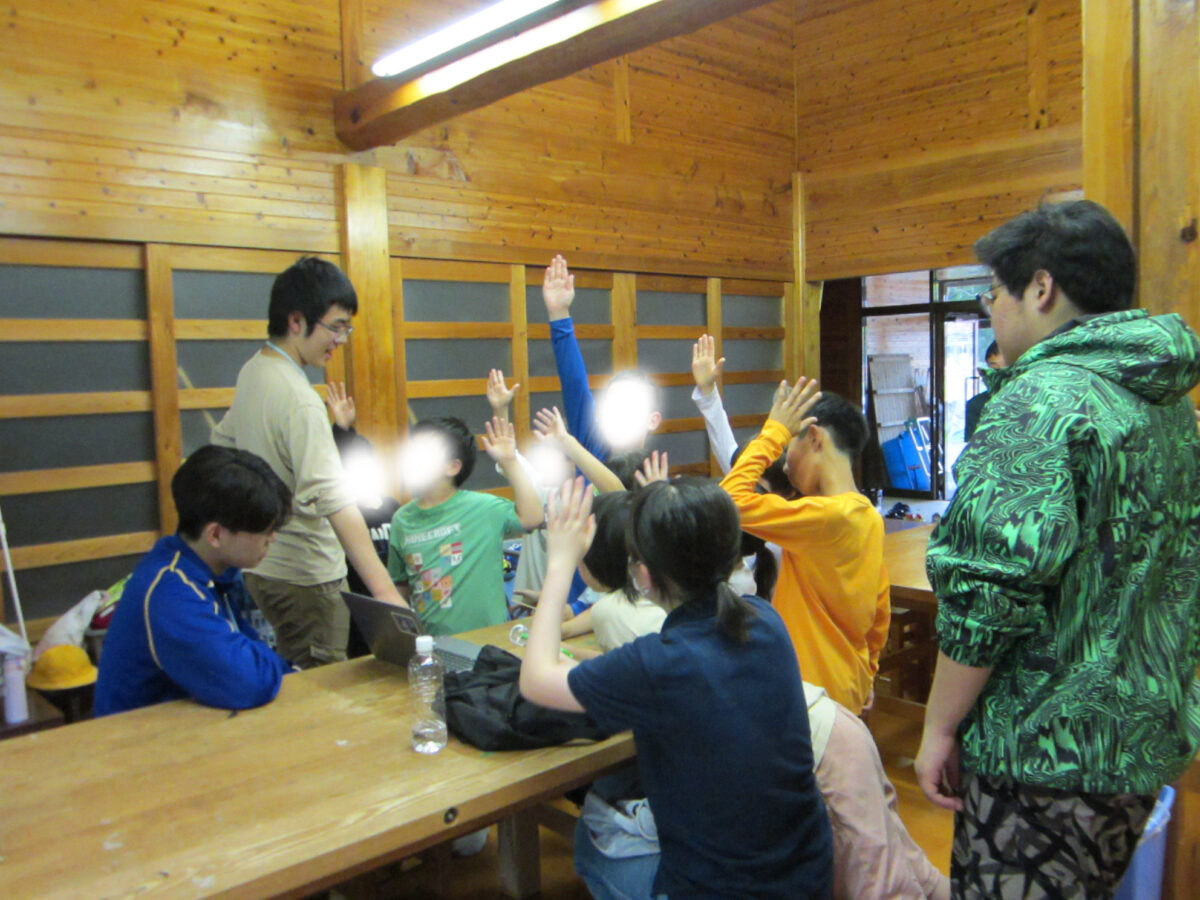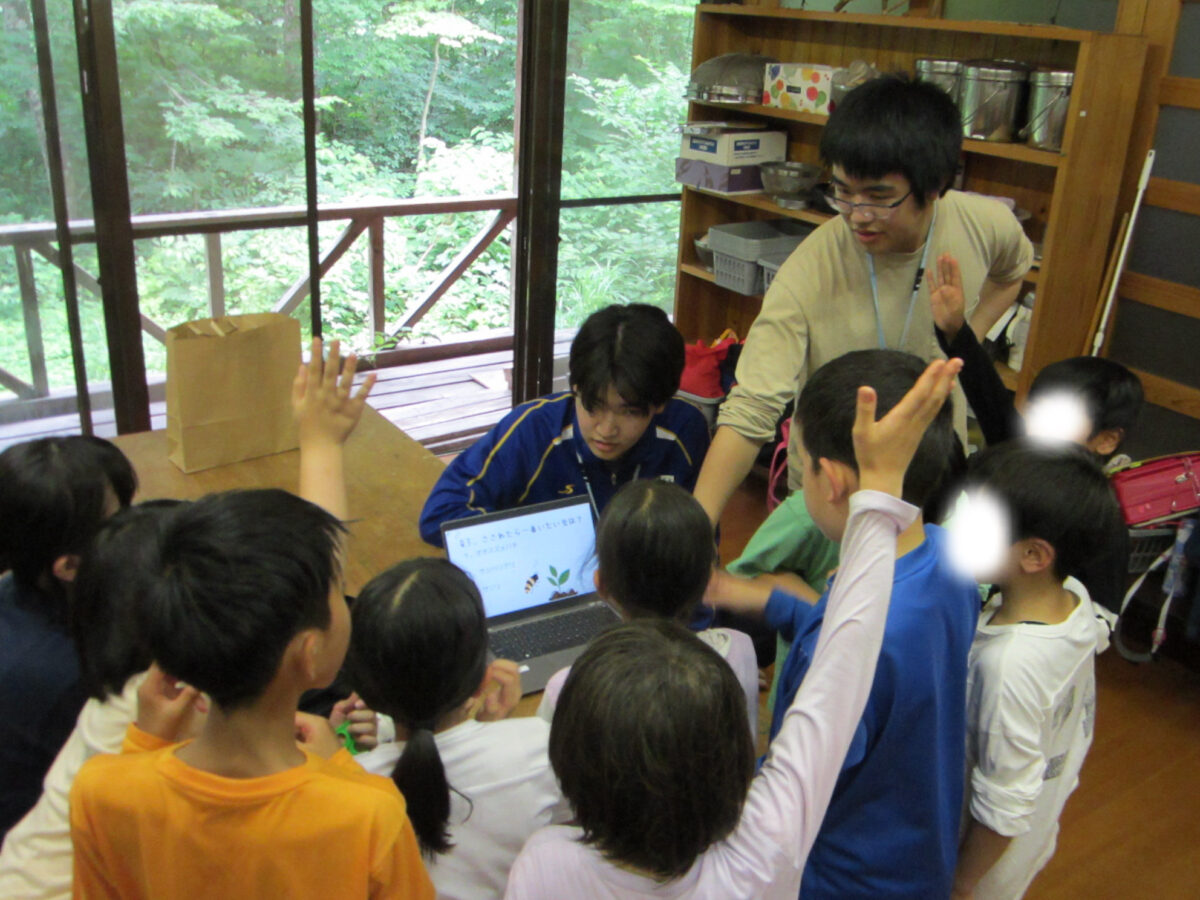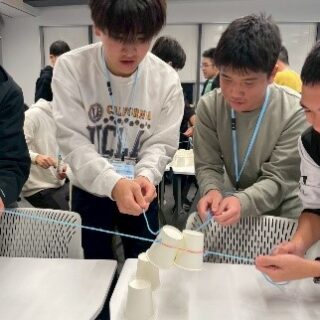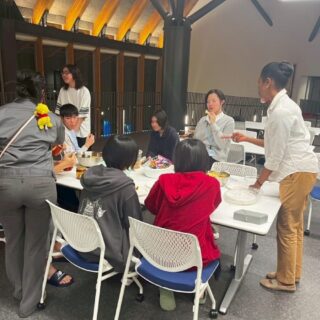Extracurricular Activity
課外活動
夏といえば虫の季節。冬でもカメムシに出会えるこの白山麓キャンパスですが、やはり夏の虫は別格です。よね?
こんにちは。つついです。6月末、地区のコミュニティセンターが主催する白嶺小学生の放課後活動に、本学の学生と一緒に参加してきました。
授業が3限で終わる水曜日の放課後、2年の中澤 円香さん、1年の大澤 凱さん、坂井 麗央さん、樋口 洸太朗さんの4名が、キャンパスから車で3分ほどの所にある小中学校裏の森で、地域の子どもたちと虫とり交流を楽しみました。大澤さんはMy網持参です。
私たちが到着したときには、低学年の子どもたちが元気いっぱいに虫とりの真っ最中で森はにぎやかな声に包まれていました。しばらくして高学年の子どもたちが合流し、全員で虫とりがはじまると、森はさらににぎやかになりました。
「虫とり」といえば、網を手にチョウやトンボを追いかけたり、木にとまったセミやクワガタ、跳ねるバッタやコオロギをつかまえたりする、そんなイメージがありませんか。ところが、低学年の子どもたちが見つけるのは、葉っぱや枝にひっそりと潜んでいる小さな虫たち。「ここにいるよ!」と虫の居場所を指さしてくれるのですが、あまりにも小さく、葉の色に同化しているうえに、最近は老眼もあってなかなか見つけられません。そんな私には見えない虫を、子どもたちは、はさみの先にカプセルのついた道具を使って確実につかまえていきます。
初夏という季節柄、虫たちもまだ成長途中なのかもしれません。でも、彼らにとってはどんなに小さな虫でも立派な「虫」。見つけた瞬間の歓声とキラキラした目がとても印象的でした。
この日、子どもたちがつかまえたのは、小さな虫たちのほか、バッタ、コオロギ、クワガタ、テントウムシ、ダンゴムシ、ナナフシ・・・そしてなんとカエルまで!
虫とりのあとは、学生たち手作りの虫クイズで盛り上がりました。虫とりに参加している子どもたちはさすがの知識量。難問にも次々と正解していました。
本校の学生たちは、それぞれの関わり方で子どもたちとの交流を楽しんでいました。普段キャンパスから眺めている空や森が、きっと、いつもとは違って見えたことでしょう。
白山麓キャンパスは自然に囲まれていますが、平日は校舎内での学びが中心で、自然や地域の人たちとふれあう時間はそれほどないのが現実です。加えて交通の便がよくないため、休日に気軽に白山麓を散策するということも難しい環境にあります。
今回、短い時間でしたが、学生たちは地域社会の一員であるという自覚が持て、「本当の自然」を肌で感じる体験ができたのではないかと感じています。
虫とりから3か月が過ぎ、あの小さな虫たちは大きくなったのでしょうか……。今なら、私の目でも見えるかもしれません。
つつい まさこ
Summer is here, and with it comes the season of insects. Even in winter, we encounter stink bugs on the Hakusanroku Campus, but summer insects are truly in a class of their own, aren’t they?
Hello, this is Tsutsui. At the end of June, I joined an after-school activity for Hakurei elementary school students organized by the local community center, together with students from ICT students.
On a Wednesday afternoon after third period classes ended, four students—Madoka Nakazawa (2nd year), Kai Osawa (1st year), Reo Sakai (1st year), and Kotaro Higuchi (1st year)—visited a forest behind a nearby elementary and junior high school, just a three-minute drive from Hakusanroku Campus to enjoy insect catching with local children. Kai even brought his own insect net!
When we arrived, the younger Hakurei students were already energetically catching insects, and the forest was filled with lively voices. Later, older grades hakurei students joined in, and the forest became even more vibrant as everyone began catching insects together.
When you think of “insect catching,” you might imagine chasing butterflies and dragonflies with a net, or catching cicadas, beetles, grasshoppers, and crickets. However, the younger hakurei students were finding tiny insects quietly hiding on leaves and branches. They would point and say, “Here it is!”—but the insects were so small and blended in with the leaves that I couldn’t see them, especially with my aging eyes. The Hakurei students skillfully used a tool, which has a capsule at the end of a pair of tweezers, to catch them quickly and easily.
Perhaps because it was early summer, the insects were still in the process of growing. But to the hakurei students, even the tiniest insect was a real “bug.” Their excited cheers and sparkling eyes when they found one were truly memorable.
That day, the hakurei students caught not only tiny insects, but also grasshoppers, crickets, beetles, ladybugs, pill bugs, stick insects—and even a frog!
After the insect catching, ICT students hosted a original insect quiz, which was a big hit. The hakurei students, already knowledgeable from their insect-catching experience, answered even the difficult questions with ease.
The ICT students enjoyed interacting with the hakurei students in their own unique ways. The sky and forest they usually see from campus must have looked quite different that day.
Although Hakusanroku Campus is surrounded by nature, students mostly study indoors during the week, and don’t often have opportunities to interact with the local community or nature. Moreover, due to limited transportation options, it’s not easy to explore the area on weekends.
This short experience gave the ICT students a chance to feel like part of the local community and to truly connect with nature.
I wonder if those tiny insects have grown bigger… Maybe now, even I could spot them.
Three months have passed since we went bug catching. I wonder if those tiny insects have grown... Maybe now, even I could see them with my own eyes.
Tsutsui Masako
 こんにちは。白山麓キャンパスで上級リーディング・ライティングの授業を担当しているステファニー・レノルズです。2025年6月18日(水)、アメリカ、ミズーリ州コロンビア市から訪れた5名の高校生が「上級リーディング・ライティングⅠA(1年生)」の授業に参加しました。この授業は5名の学生が受講しているので、アメリカからの高校生とICTの学生が、ぴったり1組ずつペアを組んでアクティビティを行うことができました。
こんにちは。白山麓キャンパスで上級リーディング・ライティングの授業を担当しているステファニー・レノルズです。2025年6月18日(水)、アメリカ、ミズーリ州コロンビア市から訪れた5名の高校生が「上級リーディング・ライティングⅠA(1年生)」の授業に参加しました。この授業は5名の学生が受講しているので、アメリカからの高校生とICTの学生が、ぴったり1組ずつペアを組んでアクティビティを行うことができました。
授業の始めに、ICTの学生とアメリカの高校生が最近読んでいるものについて話し合い、それからICTの学生は読書ログを更新しました。この上級リーディング・ライティングⅠAの授業では、今学期の15週間の授業期間中に最低8時間、好きな読み物を自主的に読み、読書時間を記録することになっています。ラーニングセッションや他の授業で読んだ時間も英語のものであれば、読書時間として含めることができます。他の人が何を読み、それについてどう感じたのかを聞くことで新たな発見と読書への意欲が高まりました。
次の活動では、単語の復習を行った後、プラスチックの歴史と発展について書かれた2ページの記事を読みました。学生たちはペアになって、読解問題に取り組みながら、本文に直接書かれていない内容を推測して答える練習もしました。
最後の課題は文法問題です。学生たちは10問の質問に答えながら、「used to」や「would」といった過去の習慣を表す表現を使って文を作成しました。ここでは、それぞれの表現をどんな場面で使うか、そして否定文に変えるかを考えることが重要でした。まずは文章を作成し、学生たちは立ち上がって教室内を歩き回りながら、お互いに自分の文を紹介し合いました。
今回の交流は、ICTの学生とアメリカから来た高校生にとって、言葉と文化を交換するとても素晴らしい機会となりました。今後もメールのやり取りを通じてペンパルとしてより深い交流を築けていけたら素敵ですね。
ステファニー・レノルズ

Hello, I am Stephanie Reynolds, an English Teacher in charge of the Advanced Reading & Writing courses at Hakusanroku campus. On Wednesday, June 18th, 2025, 5 international exchange students from Columbia, Missouri, USA joined my 1st year International College of Technology-Kanazawa (ICT) Advanced Reading & Writing IA class. The class typically has five students, so the American students and ICT students were perfectly matched 1-to-1 as partners for the class activities.
We began the class by discussing what both the ICT students and American students have been reading recently, in addition to the ICT students updating their reading logs. Over the 15-week semester, students in the Advanced Reading & Writing IA class are expected to log a minimum of 8 hours of free, independent reading time. They can include the time spent reading during learning sessions and other classes, as long as the content is in English. It was exciting and motivating to hear what others have been reading and what they thought about their chosen texts.
The next activity involved reviewing vocabulary and reading a 2-page article about the history and development of plastics. Students worked together with their partners to answer reading comprehension questions and practice the target skill of using inference to answer questions that are not directly addressed in the text.
The final task was a grammar exercise, in which all students answered a list of 10 questions and made sentences using the habitual past forms used to and would. The challenge was to decide when to use each type of form and how to adapt the forms to negative statements. The activity was written first, then students stood up and shared their sentences with one another while mingling in the classroom.
It was a wonderful opportunity to exchange language and cultural knowledge between ICT and American students. In the future, hopefully we can continue our exchange through writing emails and developing a deeper connection as pen pals.
Stephanie Reynolds

こんにちは!白山麓キャンパス、ラーニングメンターのシャーデー・モーアです。2025年6月7日(土)、白山麓キャンパスではアメリカ、ミズーリ州コロンビア市からの高校生5名の訪問を歓迎しました。同じくコロンビア市から来た2名の引率の先生とともに、5名の高校生は白山麓キャンパスで本校の学生と一緒に授業に参加し、白山市や金沢市周辺でさまざまな活動にも取り組みました。6月9日(月)のラーニングセッションでは学生同士の交流のためアイスブレイクを行いました。
ラーニングセッションの始めに、全員が数学の教室に集合しました。まずは、学生たちに課題や宿題、今後のイベントなど通常のアナウンスを行いました。その後は、お待ちかねの楽しい時間の始まりです!ラーニングメンターたちは、みんなの眠気をさまして緊張をほぐしてもらうためにゲームをすることにしました。
始めのアイスブレイクは「フルーツバスケット」です。皆が円になって座り、一人だけ円の中央に立ちます。中央にいる学生は、何か自分に当てはまることを英語で言います。好きな食べ物、好きな色、飼っているペット、好きな授業など何でもかまいません。共通点のある人は、立ち上がって別の空いている椅子に移動します。例えば、「好きな色はピンクです」や「ペットに魚を飼っています」ではあまり多くの学生に共通しないため動きがありません。しかし、「私は人間です」や「動物が好きです」だと多くの学生が席を移動しますし、さらに「フルーツバスケット」では全員が移動するため大混乱になります!皆、座席を探し、取り残されないように必死になって楽しんでいました。
ラーニングセッションでは「ハウス」という、ハリーポッター、ホグワーツ魔法魔術学校のように学生全員を4つのグループに分けています。宿題をしたり、課題を終わらせたり、クラスメイトを助けたり、後片付けなどの良い行動をすることでグループのポイントを獲得できるため、同じグループ同士協力して競い合います。逆に、ラーニングセッション中にうるさくしたり、課題を提出しない、片付けをしないなどの、不適切な態度などがあればポイントが減点されることもあります。コロンビア市から来た高校生がICTに馴染めるように、ラーニングメンターたちは高校生を4つのグループにそれぞれ入ってもらうことにしました。そこでホグワーツ行事にちなんだ「組み分け儀式」を行い、それぞれのグループに温かく迎えられました。
グループへの振り分けの後は、最後のアイスブレイクとなる英語での「ジェスチャーゲーム」を行いました。通常はジェスチャーでのみで伝えるゲームですが、今回は英語でのみヒントを出すという特別ルールで行いました。チームメイトと協力して英語でヒントを出し、できるだけ早く正解できるように奮闘しました。最初に正解を当てたグループには20ポイント、2番目のグループは15ポイント、3番目は10ポイント、最後4番目のグループは5ポイントを獲得しました。学生たちはとても楽しんで英語を使い、多くのポイントを得るために協力していました!
ゲームを楽しんだ後は通常のラーニングセッションに戻りました。課題や宿題、プレゼンテーションなど、それぞれ必要なことに取り組む学生もいれば、自由時間がある学生はお互いをもっと知るために交流を深める姿も見受けました。アイスブレイクを通して学生たちが一緒に笑い合い、文化の壁を越えて交流している様子を見ることができ、とても素晴らしい時間でした。この経験が素晴らしい思い出となり、ICT とコロンビア市から来た高校生たちの良好な関係を築く第一歩となったことでしょう。
シャーデー・モーア

Hello again! This is Sade Moore, a Learning Mentor at the Hakusanroku Campus! From Saturday, June 7th, 2025, International College of Technology (ICT) has had the pleasure of hosting a delegation of 5 high school students from Columbia, Missouri, United States at the Hakusanroku Campus. Along with two teachers from Columbia they have been participating in classes at the Hakusanroku Campus with our students and also various activities in and around Hakusan City and Kanazawa City. To facilitate welcoming them to our school the Learning Mentors decided to have a quick Ice Breaking Session for the students during the beginning of Learning Session on Monday, June 9th.
At the beginning of Learning Session, we gathered all of the students together in the Math Classroom. We started with normal announcements for our students to tell them about their necessary assignments and homework and any events that are going to happen soon and after the announcements the fun could begin! First, to wake up the students and let everyone loosen up, the Learning Mentors decided to play a game as most of the students seemed sleepy and not interested.
The first ice breaker that we played is called “Fruit Basket.” It is a game where all the students sit in a circle and one student is in the middle. The student in the middle has to say, in English, something that pertains to them. It can be anything like what food they like, what color they like, what pet they have, or what class they like. After the student says the statement, then for the students who have the same answer, they must get up and move to a different chair. For students who say things like “my favorite color is pink” or “I have a pet fish” not many students can say the same so not many students move. But for statements like “I am a human” or “I like animals” or “Fruits Basket (where all the students have to move chairs)”, it can cause a lot of chaos as most students have to move to a different seat! The students had a lot of fun trying to find a new chair and not be the student left in the middle.
At the ICT Hakusanroku Campus we have implemented a House System where all of the students are separated into 4 separate houses. The students have to work together with their Housemates to collect points based off of good behavior, such as doing their homework, completing assignments, helping their other classmates, and cleaning up after themselves. They can also lose points if they behave badly, for example, if they are being too loud during Learning Session, not completing assignments, not cleaning up after themselves, and not acting in an appropriate manner. To help integrate the American students into ICT, the Learning Mentors thought it would be a good idea to sort the American students into one of the 4 ICT Houses. So, we held a quick sorting ceremony for them and they were quickly welcomed into their houses by their ICT house members.
With the sorting done this led into our final ice breaking activity of the night where we would play English-only Charades. In a usual game of charades there are only gestures used to try and guess a secret word. However, today for charades the students must give hints in English only as to what the secret word was. Each house had to work together to give the best hints so that their teammate could guess correctly as fast as possible. The first House to guess correctly would receive 20 House Points, 2nd fastest would get 15 House Points, 3rd would get 10 House Points, and the last team to guess the answer would get 5 House Points. The students really enjoyed working together to use their English in order to get as many points as possible!
After English-only Charades the ICT students and the American students were all released to regular Learning Session to work on any assignments, homework, or presentations that they needed to get done or to get to know each other better if they had free time. It was really nice to see all of the students laughing and smiling together and crossing cultural barriers through the Ice Breaking Activity. It is the Learning Mentors’ hope that this will lead to good memories and a great start to good relations between our students and the students from Columbia.
Sade Moore
 ラティヤ・メブサヤです。ジェーンと呼んでください。私はタイ出身です。金沢と白山麓の両キャンパスで主にイノベーション(技術革新)とアントレプレナーシップ(起業家精神)に関する授業をトッサ・メブサヤ先生と担当しています。2025年6月8日は私たちが日本へ来てICTで働き始めて3年が経過した記念の日となりました。私は昨年までは非常勤勤務でしたが、今年度から常勤として勤務しています。私は、中沢教授の研究室の下で金沢工業大学大学博士後期課程を修了し、日本に来るまでの2年半の間、ところどころでサポートする形で一時的に働いていました。現在は金沢キャンパスをメインに、金沢と白山麓の両キャンパスで活動しています。
ラティヤ・メブサヤです。ジェーンと呼んでください。私はタイ出身です。金沢と白山麓の両キャンパスで主にイノベーション(技術革新)とアントレプレナーシップ(起業家精神)に関する授業をトッサ・メブサヤ先生と担当しています。2025年6月8日は私たちが日本へ来てICTで働き始めて3年が経過した記念の日となりました。私は昨年までは非常勤勤務でしたが、今年度から常勤として勤務しています。私は、中沢教授の研究室の下で金沢工業大学大学博士後期課程を修了し、日本に来るまでの2年半の間、ところどころでサポートする形で一時的に働いていました。現在は金沢キャンパスをメインに、金沢と白山麓の両キャンパスで活動しています。
私とトッサ先生のここでの目標は、学生向けの起業プログラムを作り上げることです。これまでの3年間はいい時もあれば、そうでない時もありました。ワクワクすることもありましたし、その間にもさまざまな出来事がありました。どれも素晴らしい経験であり、チャンスに満ちた時間でした。これまでに取り組んできたことのなかには、成果を上げたものもあれば、今なお時間や調整を要するものもあります。スタートアップや起業家のマインドセットでは、すべてがチャンスであり、失敗もまた学びの機会です。大切なのは、常に前進し、素早く行動を起こすことです。
スタートアップおよび起業家プログラムでの学生たちの様子をとても素晴らしく思います。この活動の中で、今後も多くのチャンスや学びの機会が待っているはずです。私たちは、単に教室の中で学ぶだけでなく、起業家精神やスタートアップ・マインドセットの育成には、一貫した取り組みと予測できない状況下での経験が必要と考えています。また、成功する学びの環境を作るためには、私たちも強固なエコシステムの一員であることが不可欠です。
まだ最終的な目標には届いていませんが、これまでに金沢キャンパスと白山麓キャンパスにて積み上げてきた取り組みを写真と共に紹介します。まずは、2023年と2024年に開催した「スタートアップ・ブートキャンプ」です。このブートキャンプは、スタートアップに関心のあるすべての人を対象としたもので、ICTの学生だけでなく、KITの学生、さらには教職員も対象としています。約2年間取り組んでおり、今年度私たちのスタートアップは、成長の次なる段階へと移行します。
【スタートアップ・ブートキャンプ】
次に2024年と2025年に開催した「ICT Startup Competition」です。このイベントでは、日本および世界のスタートアップの動向について参加者に伝え、最新情報を提供するために、パネルディスカッションを行いました。日本国内外のスタートアップや投資家、Tech Startup HOKURIKU(TeSH:テッシュ)や政府関係者などといったスタートアップ・エコシステムの主要な関係者を招きました。パネルの後はビジネスアイデアを競う、ピッチコンペティションが行われました。ICTとKITの他にもタイ、ベトナム、マレーシアなど他国の大学からもチームを募集しました。次回の開催では、さらにインターナショナルに、多くの他国からの大学やKOSEN(高専)からの参加を期待しています。
ICT Startup Competition 2024

ICT Startup Competition 2025

またこれまでに、Matching HUB HokurikuやShsHi Tech Tokyo、海外の大学への訪問などを通じて起業家やエコシステム内での関係も築いてきました。さらに、学生たちとは「高専起業家サミット」や「みんなの夢AWARD15」への参加を通して指導を行ってきました。
【高専起業家サミット】
国内、海外の様々なアントレプレナーシップのイベントを訪れた際の様子等
現在、金沢キャンパスを拠点としています。イノベーション、スタートアップ、アントレプレナーシップに興味のある方は気軽にお立ち寄り頂ければ私たちのイノベーションラボをご案内します。また私たちの活動内容や詳細に興味のある方は、Facebookでもご覧いただけますので、こちらのページを是非ご覧ください。
https://www.facebook.com/share/g/1Gi66wGeQo/
今後は、現在活躍している起業家について学んだり、アイデアを共有したり、社会での課題解決を短くカジュアルなピッチで行うイベントを、誰でも参加できる形で開催する予定です。垣根を越えてアイデアを共有できることを楽しみにしています。
忙しい一日の終わりに金沢キャンパスでの遊びの時間。想像力を刺激する体験がいつも待っています。

ラティヤ・メブサヤ
 I’m Rattiya Mebusaya—or just call me Jane—and I’m from Thailand. The classes, Tossa Mebusaya and I are responsible for are mostly related to innovation and entrepreneurship in both Kanazawa and Hakusanroku campus. On June 8th, it was the anniversary of our being here and working for 3 years. I’m kind of a new full-time employee at ICT, but I’m not new here. I graduated from KIT studying in Nakazawa Sensei’s lab and had been temporarily working at ICT’s Kanazawa office—helping out here and there—for two and a half years. Now, I’m mostly at the Kanazawa campus but work at the Hakusanroku campus from time to time.
I’m Rattiya Mebusaya—or just call me Jane—and I’m from Thailand. The classes, Tossa Mebusaya and I are responsible for are mostly related to innovation and entrepreneurship in both Kanazawa and Hakusanroku campus. On June 8th, it was the anniversary of our being here and working for 3 years. I’m kind of a new full-time employee at ICT, but I’m not new here. I graduated from KIT studying in Nakazawa Sensei’s lab and had been temporarily working at ICT’s Kanazawa office—helping out here and there—for two and a half years. Now, I’m mostly at the Kanazawa campus but work at the Hakusanroku campus from time to time.
Tossa and I have a mission here to build an entrepreneurship program for students. In these past three years, it has been good, bad, exciting, and many other things in between. It has been a great experience and full of opportunities. We have done so many things so far—some have paid off, and some still need time and adjustment. With the startup and entrepreneur mindset, everything is an opportunity, and every failure is a lesson. We just need to move forward and act fast.
We’re really proud of our students in the startup and entrepreneur program. There will be more opportunities and learning throughout this long journey. We have not only taught students in classes—since entrepreneurship and a startup mindset need consistency and real-world, uncertain experiences—we also need to be part of a strong ecosystem to create a successful learning environment.
Even though we have not yet completely fulfilled all our goals, these are the activities we’ve built up so far at both the Kanazawa and Hakusanroku campuses. Here are some pictures of what we’ve done so far at ICT—our first and second KIT & ICT Startup Boot Camps. These boot camps were created to educate and support anyone interested in startups—not just ICT students, but also KIT students and even faculty and staff. We've been running them for about two years. This year, we will move to the next stage of startup development.
Startup Boot Camp
Next are our first and second ICT Startup Competitions. In these events, we’ve hosted a couple of interesting panels to educate and update participants on both Japanese and global startup trends. We’ve invited Japanese and international startups, investors, and other key ecosystem players such as Tech Startup HOKURIKU(TeSH), government representatives, and more. After the panels, we held a pitching competition. We’ve recruited teams from ICT, KIT (although no one from KIT has joined yet), and universities in other countries such as Thailand, Vietnam, and Malaysia. We hope that in the coming year, we’ll have more international teams as well as local teams from other universities, colleges, and technical colleges or KOSENs.
ICT Startup Competition 2024

ICT Startup Competition 2025

We’ve also built connections with entrepreneurs and others in the ecosystem through important events such as the Matching HUB Hokuriku, SusHi Tech Tokyo, and visits to universities in other countries. Lastly, we have been coaching our students for competitions such as the Entrepreneurship KOSEN Summit and the High School Students’ Dream Award.
Entrepreneurship KOSEN Summit
Other Entrepreneurship Events
Right now, our office is based at the ICT Kanazawa campus. If anyone is interested in Innovation, Startups, or Entrepreneurship, please feel free to swing by and see us at the Innovation Lab—we’d love for you to get to know us. Or, if you’d like to learn more about us first, you can also visit our Facebook page to see more details and activities。
https://www.facebook.com/share/g/1Gi66wGeQo/
In the future, we plan to host events that anyone can join to learn more about current entrepreneurs or share ideas—even short, casual pitches on solving real-world problems. It will be fun to share ideas without boundaries.
Play time at ICT Kanazawa after a hard day’s work. There are always opportunities for creativity and excitement.

Rattiya Mebusaya
 白山麓キャンパスに積もっていた雪が溶け、小さな春の蕾の開花とともに、ここに集まった新入生たちも新たな門出の日を迎えました!
白山麓キャンパスに積もっていた雪が溶け、小さな春の蕾の開花とともに、ここに集まった新入生たちも新たな門出の日を迎えました!
こんにちは。ラーニングメンターのドミソン・アブワンです。私たちラーニングメンターは主に、白山麓キャンパスで学校生活を送る1・2年生と共に活動します。2025年4月、ここ白山麓キャンパスでは、新たな学び、成長、生活への旅路に立った新入生たちを歓迎しました。
平日の19:30~21:30まで、勉強や宿題、学習習慣を身につけるための「ラーニングセッション」を開催しています。もちろん、私たちラーニングメンターはそこで学習指導やサポートしたり、時には親身になって話をしたりします。
新入生がこの新しい環境に溶け込み、友達を作り、新学期をスタートできるよう、私たちは、楽しく充実した時間になるようなイベントを企画しました。
ラーニングセッション オリエンテーションからスタート
4月4日(金)、1・2年生がラーニングセッションのオリエンテーションに参加しました。私たちラーニングメンターは自己紹介をし、ラーニングセッションについて説明をしました。通常の授業と同じようにラーニングセッションもガイドラインに沿って、夜の時間を有効に使います。
その中で大切なことは、そう英語です!ラーニングセッションの時間は英語を使用し、3年生でのニュージーランド留学に備えて英語での生活に慣れることができるのです。
また、今年の新しいアクティビティーとして、学生の現在の英語レベルに合わせた記事を読み、質問に答えることで読解力を磨く「リーディング・ラボラトリー」を導入することとなりました。
その後は、1年生を対象にラーニングセッションで活用する場所について案内を行いました。アナウンスの掲示場所、学習資料の場所、静かな学習やグループワーク、ワークショップに使われる部屋などを簡単に紹介しました。
続いては、楽しみにしていた時間です。
ゲームや笑い合いを通して打ち解ける
オリエンテーションの部屋に戻り、チームビルディングゲームが始まりました!始めに「カップスタックチャレンジ」を行いました。これは少人数のグループに分かれ、紐付きの輪ゴム(1人につき1本)だけを使って、紙コップを積み上げて一番高いタワーを作り上げるゲームです。ハイペースで3回戦まで行われ、会場は笑いと歓声に包まれ、時にはハラハラする場面もあり、大いに盛り上がりました。優勝者にはもちろん賞品のお菓子が贈られました!
次は、趣味や興味のあることを質問する英語でのビンゴです。このゲームの目的は、できるだけ多くの学生と会話をし、ビンゴシートを完成させることです。最適なアイスブレイクとなり、全員が英語で会話や質問をし、お互いの共通点に気づくことができました。
最後に、学生たちはグループに分かれてSTEM(理科科目)に関する課題に取り組みました。これは、次回の化学の授業で行われる小テストに向けた課題です。化学実験室の安全性と器具の適切な使用法に関する問題を解きました。楽しい時間を過ごした後も、学生たちが協力し合い、集中力を発揮していた様子は素晴らしかったです。
グループへようこそ!
4月9日(水)、ラーニングセッションのグループ割りが発表され、学生たちは興奮に包まれました!ホグワーツ魔法魔術学校のような雰囲気ですが、魔法の呪文の代わりに宿題によってポイントが課されます。学生たちが自分のグループを見つけるたびに、(「やった!同じだ!」と)笑いと驚きの声が聞こえてきました。
一方で2年生はベテランとなり、宿題や課題をこなして、すぐに各グループのポイント獲得に取り組みました。学期末には、最も多くのポイントを獲得したグループに賞と賞品が贈られます。切磋琢磨の始まりです!
カラオケ、ボードゲーム、みんなの笑顔
4月11日(金)は新入生のために正式な歓迎会を開きました。2年生は頼もしく、ゲームの準備を手伝い、カラオケのスタートを切ってくれました!
学生たちは一人ずつマイクを手に取り、お気に入りのヒット曲を歌いました。ソロで歌う学生や、グループで歌う学生もいれば、一緒に踊ったり、会場は活気とたくさんの笑い声で溢れていました。
ボードゲーム、カードゲーム、積み上げゲームもあり、どのゲームも歓声が沸き起こりました。コンピューターゲームにも大勢の学生が集まり、あっという間にまるで以前から友達だったかのように絆を深めていました。
歓迎会では、私たち教員もそれぞれの学生と、新生活の様子や今学期で楽しみにしていることなどを、お菓子をつまみながら和やかな雰囲気の中で気軽に英語で会話をすることができました。
“スペシャル”への飛躍
ラーニングメンターが企画したこれらのアクティビティーが、新入生たちへの温かい歓迎と、白山麓キャンパスでの新生活の力強いスタートとなれれば嬉しく思います。新学期を始めるにあたり、これからラーニングセッションの時間にワークショップ、季節のイベント、楽しくグループチャレンジを開催していくことを楽しみにしています。
今後も続きをお伝えしていきますね。
ドミソン・アブワン

As the last patches of snow melted from the Hakusanroku campus grounds and tiny buds of spring began to bloom, something else started fresh, too—our newest batch of freshmen!
Hi, I’m Domyson Abuan, one of the Learning Mentors (LMs) here at ICT, and our team works closely with both 1st and 2nd year students. This April 2025, we opened our doors to welcome the incoming students who are just beginning their journey of learning, growing, and living here at the Hakusanroku campus.
Each weeknight from 7:30 P.M. to 9:30 P.M., we run Learning Sessions (LS)—a time dedicated to studying, doing homework, and building good study habits for students. And of course, us LMs are there to guide, support, and sometimes, just be a friendly face to talk to.
To help our 1st year students ease into this new environment, we planned some fun and meaningful events to help them meet their schoolmates, and get a head start on the semester.
Kicking Things Off: Learning Session Orientation
On Friday, April 4th, both 1st and 2nd year students gathered for our LS Orientation. We LMs introduced ourselves and gave a quick rundown of what the session is all about. Just like their morning classes, LS has a set of guidelines so everyone knows how to make the most of their evenings.
One important part? English time! Students are encouraged to use English during LS so they can get used to it in preparation for their life in New Zealand when they are 3rd year students.
We also introduced this year’s new activity: a Reading Laboratory where students read an article suited to their current level and answer a few questions to sharpen their reading comprehension.
Afterwards, the 1st year students were given a short tour around the LS spaces—like where to find the announcements, where to grab study materials, and which rooms are used for quiet study and group work.
Then, the real fun began.
Games, Giggles, and Getting to Know Each Other
Back in the orientation room, it was time for some team-building games! First up was the Cup Stack Challenge. Divided into small groups, students had to work together using only a rubber band with strings (one per teammate) to stack paper cups into the tallest tower. With three rounds of fast-paced building, the room was filled with laughter, cheering, and a few dramatic cup crashes. Winners, of course, got snack prizes!
Next was English Bingo, with questions about hobbies and personal interests. The goal? Talk to as many classmates as possible to complete your bingo sheet. It was a great icebreaker and got everyone chatting in English, asking questions, and realizing they already have things in common.
To wrap things up, students worked together in groups to complete their STEM (Science subject) worksheets—an actual study task to help them prep for an upcoming quiz in their Chemistry class. They answered questions on laboratory safety and proper use of apparatus. We were really proud of how well they collaborated and focused, even after all the fun.
Welcome to the House System!
On Wednesday, April 9th, excitement was in the air as the students were sorted into their Houses! Think Hogwarts vibes, but with homework points instead of magic spells. As each student discovered their house, you could hear laughter and surprise (“Yay! I'm with you!”) across the room.
Meanwhile, the 2nd years, now seasoned pros, jumped right into earning points for their houses by completing homework and doing tasks. At the end of semester, the house with the most points wins the House Cup and a special reward. Let the friendly competition begin!
Karaoke, Board Games, and Bright Smiles
To officially welcome the new students, we held a Welcome Party on Friday, April 11th. The 2nd years really stepped up—they helped set up games and even kicked off the karaoke session!
One by one, students took the mic and sang their favorite hits. Many sang solo, some in groups, and others danced along. The room buzzed with energy and lots of laughter.
There were board games, card games, and stacking challenges too—each bringing out bursts of cheers. A computer game even pulled a huge crowd, and before long, many were playing and bonding like old friends.
Throughout the party, us teachers made our rounds, casually chatting with students in English about how they were settling in and what they looked forward to the most this semester - the chats were made more fun of course by delicious snacks.
A Springboard into Something Special
We hope these activities gave our freshmen a warm welcome and a strong start to their life here at Hakusanroku campus. With a new semester ahead, we're excited for more workshops, holiday events, and fun group challenges during our Learning Sessions.
And yes—we’ll definitely keep you posted.
Domyson Abuan











